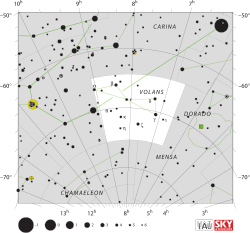Zeta Volantis
Zeta Volantis (ζ Vol, ζ Volantis) is a binary star[11] system in the southern constellation of Volans. It has an apparent visual magnitude of 3.93,[2] which is bright enough to be seen with the naked eye. Based upon parallax measurements, it is approximately 141 light years from the Sun.[1] The companion is a magnitude 9.7 star at an angular separation of 16.7″.[11] Based upon their motion through space, this system made its perihelion passage some 858,000 years ago when it came within 22 ly (6.6 pc) of the Sun.[12] It is currently moving away with a radial velocity of 48 km/s.[4]
 | |
| Observation data Epoch J2000.0 Equinox J2000.0 | |
|---|---|
| Constellation | Volans |
| Right ascension | 07h 41m 49.26100s[1] |
| Declination | −72° 36′ 21.9566″[1] |
| Apparent magnitude (V) | 3.93[2] |
| Characteristics | |
| Spectral type | K0 III[3] |
| B−V color index | +1.03[2] |
| Astrometry | |
| Radial velocity (Rv) | +48.1±0.7[4] km/s |
| Proper motion (μ) | RA: +33.34[1] mas/yr Dec.: +14.89[1] mas/yr |
| Parallax (π) | 23.13 ± 0.12[1] mas |
| Distance | 141.0 ± 0.7 ly (43.2 ± 0.2 pc) |
| Absolute magnitude (MV) | +0.75[5] |
| Details | |
| Mass | 1.74[6] M☉ |
| Radius | 11[7] R☉ |
| Luminosity | 53[8] L☉ |
| Surface gravity (log g) | 2.43±0.10[9] cgs |
| Temperature | 4,721±57[9] K |
| Metallicity [Fe/H] | −0.18±0.05[9] dex |
| Age | 5.27[6] Gyr |
| Other designations | |
| Database references | |
| SIMBAD | data |
The primary component is K-type giant star with a stellar classification of K0 III.[3] It has a derived luminosity of around 53 times that of the Sun,[8] 1.74 times the Sun's mass and is about 5.27 billion years old.[6] The measured angular diameter of this star is 2.32±0.06 mas.[13] At the estimated distance of Zeta Volantis,[13] this yields a physical size of about 11 times the radius of the Sun.[7] The expanded outer envelope has an effective temperature of 4,721 K,[9] giving it the orange glow of a K-type star.[14]
References
- van Leeuwen, F. (2007), "Validation of the new Hipparcos reduction", Astronomy and Astrophysics, 474 (2): 653–664, arXiv:0708.1752, Bibcode:2007A&A...474..653V, doi:10.1051/0004-6361:20078357.
- Cousins, A. W. J. (1977), "UCBV Magnitudes and Colours of South Circumpolar Stars", South African Astronomical Observatory Circulars, 1: 51, Bibcode:1977SAAOC...1...51C.
- Houk, Nancy; Cowley, A. P. (1979), Michigan catalogue of two-dimensional spectral types for the HD stars, 1, Ann Arbor, Michigan: Dept. of Astronomy, University of Michigan, Bibcode:1978mcts.book.....H.
- Gontcharov, G. A. (November 2006), "Pulkovo Compilation of Radial Velocities for 35,495 Hipparcos stars in a common system", Astronomy Letters, 32 (11): 759–771, arXiv:1606.08053, Bibcode:2006AstL...32..759G, doi:10.1134/S1063773706110065.
- Anderson, E.; Francis, Ch. (2012), "XHIP: An extended hipparcos compilation", Astronomy Letters, 38 (5): 331, arXiv:1108.4971, Bibcode:2012AstL...38..331A, doi:10.1134/S1063773712050015.
- Luck, R. Earle (2015), "Abundances in the Local Region. I. G and K Giants", The Astronomical Journal, 150 (3): 88, arXiv:1507.01466, Bibcode:2015AJ....150...88L, doi:10.1088/0004-6256/150/3/88.
- Lang, Kenneth R. (2006), Astrophysical formulae, Astronomy and astrophysics library, 1 (3rd ed.), Birkhäuser, ISBN 3-540-29692-1.. The radius (R*) is given by:
- McDonald, I.; et al. (2012), "Fundamental Parameters and Infrared Excesses of Hipparcos Stars", Monthly Notices of the Royal Astronomical Society, 427 (1): 343–57, arXiv:1208.2037, Bibcode:2012MNRAS.427..343M, doi:10.1111/j.1365-2966.2012.21873.x.
- Alves, S.; et al. (April 2015), "Determination of the spectroscopic stellar parameters for 257 field giant stars", Monthly Notices of the Royal Astronomical Society, 448 (3): 2749–2765, arXiv:1503.02556, Bibcode:2015MNRAS.448.2749A, doi:10.1093/mnras/stv189.
- "zet Vol -- High proper-motion Star", SIMBAD Astronomical Database, Centre de Données astronomiques de Strasbourg, retrieved 2016-09-05.
- Eggleton, P. P.; Tokovinin, A. A. (September 2008), "A catalogue of multiplicity among bright stellar systems", Monthly Notices of the Royal Astronomical Society, 389 (2): 869–879, arXiv:0806.2878, Bibcode:2008MNRAS.389..869E, doi:10.1111/j.1365-2966.2008.13596.x.
- Bailer-Jones, C. A. L. (March 2015), "Close encounters of the stellar kind", Astronomy & Astrophysics, 575: 13, arXiv:1412.3648, Bibcode:2015A&A...575A..35B, doi:10.1051/0004-6361/201425221, A35.
- Richichi, A.; et al. (February 2005), "CHARM2: An updated Catalog of High Angular Resolution Measurements", Astronomy and Astrophysics, 431: 773–777, Bibcode:2005A&A...431..773R, doi:10.1051/0004-6361:20042039.
- "The Colour of Stars", Australia Telescope, Outreach and Education, Commonwealth Scientific and Industrial Research Organisation, December 21, 2004, retrieved 2012-01-16.